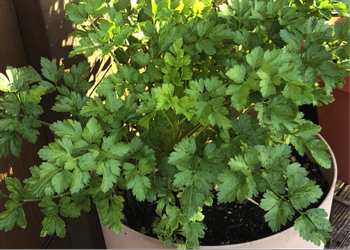Parsley
-
Scientific NamePetroselinum crispum (curly variety) Petroselinum neapolitanum (flat leaf variety)
-
General InformationPopular biennial culinary herb in the carrot family. Two varieties: curly leaf parsley used more as a garnish and flat leafed parsley used for cooking. Bright green, tooth-edged leaves. Cold hardy; sends up flower stalk after first winter. Low water requirements make it ideal for containers. Native to Mediterranean countries.
 Photo: Bonnie Marks
Photo: Bonnie Marks -
When to Plant
May plant from seed in the fall or early spring, but planting starts in early spring and in the fall is more reliable and results in an earlier harvest. Germination can be slow (two to four weeks). Fall plantings may go to seed the following spring.
-
Planting
Seeds can be started in the ground or in small containers. Can be planted in full sun or partial shade. Thin seedlings so that plants are 10 to 12 inches apart (15 inches for flat parsley). Curly parsley can be planted as a border around beds.
-
Soil Requirements
Plant in well-drained soil that is rich in organic matter. Plants prefer neutral soil, with a pH between 6.0 and 7.0.
-
Water Requirements
Water deeply once a week. Do not allow plants to dry out completely between watering days. Mulch plants to retain soil moisture.
-
Fertilizing
Little fertilizer needed – instead top dress with compost at planting and again two months later.
-
Pollination
Not required – as leaves are used, not flowers.
-
Harvesting
Harvest by snipping off stalks close to the ground, beginning with those on the outside. Allow the new growth from the middle to develop for a continuous crop.
-
Storage
Best when fresh, so snip as needed, but can be stored in the refrigerator. Leaves can be dried by hanging bunches in a warm, dry, dark place.
-
Good Varieties for Marin
'Darki Moss' Curled
'Giant of Italy' (Gigante D’Italia)
-
Helpful Tips
Grow parsley in a container near the kitchen for easy access while cooking. Anise swallowtail butterflies often use parsley as a larval host plant, and their caterpillars will start small and grow larger (and more beautiful) as they eat. Check leaves carefully before harvesting in the late spring and early summer.
Trim off outer leaves that turn yellow and then brown. Remove flower stalks to maintain growth. Harvest seed for future planting – or leave to reseed itself.
-
Common Problems
Few problems – easy to grow and disease resistant.
-
Pests- Diseases & More
Learn more about growing parsley.

